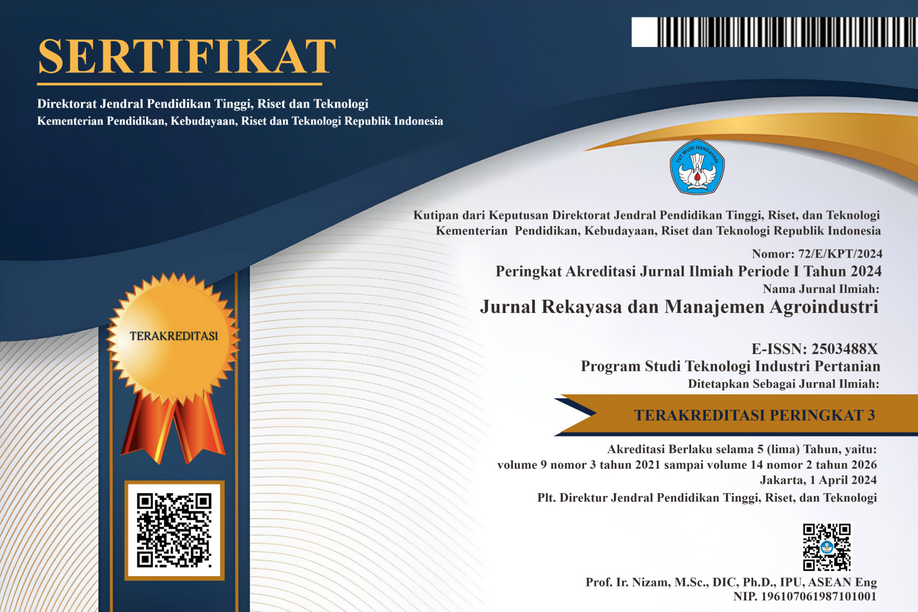Efektivitas Desinfektan Larutan Pemutih (Bayclin) dalam Mencegah Mikroba Kontaminan pada Inkubator di Laboratorium Mikrobiologi
Abstract
Contaminants in microbiological analysis often occur even though aseptic testing has been carried out. Control of the growth of microorganisms aims to eradicate unwanted microorganisms. The disinfectant used is a combination of bleach solution (bayclin) and alcohol which works by inactivating enzymes, denaturing proteins and inactivating nucleic acids. The purpose of this study was to determine the effectiveness of using a disinfectant bleach solution (bayclin) of various concentrations in preventing microbial contaminants in the incubator at the Food Microbiology Laboratory. The data collection technique in this study was in the form of an experiment, the results of surface swabs of incubator equipment that had been sprayed with 70% alcohol followed by spraying a disinfectant bleach solution (bayclin) with concentrations (0%, 5%, 10% and 15%), then testing the level of microbial contaminants by analysis of total bacteria and total yeast molds using the TPC (Total Plate Count) method with 3 repetitions. It was found that spraying disinfectant bleach solution (bayclin) had an effect on the total quantity of bacteria and total yeast mold incubated in the incubator equipment in the microbiology laboratory with the highest total bacterial cell quantity in the control treatment (bayclin 0%) of 3.7 CFU/cm2 and the smallest by 0 CFU/cm2 in the treatment of 15% bayclin concentration and the highest cell quantity of total yeast in the control treatment (0% bayclin) was 1.5 CFU/cm2 and the smallest was 0 CFU/cm2 in the 15% bayclin concentration treatment.
Keywords : bayclin, disinfectant, effectiveness, incubator, microbial contaminants
Kontaminan pada analisis mikrobiologi sering terjadi walaupun sudah dilakukan pengujian secara aseptis. Pengendalian pertumbuhan mikroorganisme bertujuan untuk membasmi mikroorganisme yang tidak diinginkan. Desinfektan yang dipergunakan yakni kombinasi larutan pemutih (bayclin) dengan alkohol merupakan bahan yang bekerja dengan inaktifasi enzim, denaturasi protein dan inaktivasi asam nukleat. Tujuan dari penelitian ini adalah untuk mengetahui efektivitas penggunaan disinfektan larutan pemutih (bayclin) dari berbagai konsentrasi dalam mencegah mikroba kontaminan pada inkubator di Laboratorium Mikrobiologi Pangan. Teknik pengumpulan data pada penelitian ini berupa eksperimen, hasil swab permukaan peralatan inkubator yang telah disemprotkan Alkohol 70% dilanjutkan dengan penyemprotan disinfektan larutan pemutih (bayclin) konsentrasi (0%, 5%, 10% dan 15%), kemudian dilakukan pengujian tingkat kontaminan mikroba dengan analisis total bakteri dan total kapang khamir menggunakan metode TPC (Total Plate Count) dengan pengulangan sebanyak 3 kali. Didapatkan hasil bahwa penyemprotan disinfektan larutan pemutih (bayclin) berpengaruh terhadap kuantitas total bakteri dan total kapang khamir yang diinkubasi pada peralatan inkubator dilaboratorioum mikrobiologi dengan kuantitas sel total bakteri tertinggi pada perlakuan kontrol (bayclin 0%) sebesar 3,7 CFU/cm2 dan terkecil sebesar 0 CFU/cm2 pada perlakuan konsentrasi bayclin 15% serta kuantittas sel total kapang kamir tertinggi pada perlakuan kontrol (bayclin 0%) sebesar 1,5 CFU/cm2 dan terkecil sebesar 0 CFU/ cm2 pada perlakuan konsentrasi bayclin 15%.
Kata kunci : bayclin, desinfektan, efektivitas, inkubator, kontaminan mikroba
Downloads
References
Bradley, D. V. 1992. Efficacy of Various Spray Disinfectants on Irreversible Hidrocolloid Impression. International Journal Prosthodont. Vol 5: 234-238.
Bujang, A., Taib, N. A. 2014. Change on Amino Acids Content in Soybean, Garbanzo Bean and Groundnut during Pre-treatments and Tempe Making Sains Malaysiana 43(4):551-557.
Darwindra, H. D. 2008. Tahapan Proses Pembuatan Laru Tempe. Diakses pada: http:www.harisblog.wordpress.com. (23 April 2020).
Duniaji, A.S., W. Wisaniyasa., N.N. Puspawati., dan N.M. Indri H. 2019. Isolation and Identification of Rhizopus oligosporus Lokal Isolate Derived from Several Inoculum Sources. International Journal of Current Microbiology and applied Sciences, Vol.8, No.9 hlm: 1085-1098.
Dwidjoseputro.1989. Dasar-Dasar Mikrobiologi. Djambatan: Malang.
Fardiaz, S.1992. Mikrobiologi Pangan. PT Gramedia Pustaka Utama: Jakarta.
Gardner, D.R., 1997. Chlorine and Chlorine Compounds 2nd ed., Philadelpia: J.B. Lipincott Company.
Hadioetomo, R.S. 1985. Mikrobiologi Dasar dalam Praktek: Teknik dan Prosedur Dasar. Gramedia: Jakarta.
Joddy, I. 2009. Studi Awal Pengembangan Jaringan Inkubator Teknologi dan Bisnis Pada Institusi Pendidikan Tinggi di Indonesia. Jurnal Matematika, Sains, dan Teknologi. Vol. 9 (1): 47-53.
Lamiah. 2016. Pengaruh Desinfeksi dengan Teknik Spray Rebusan Daun Sirih Hijau (Piper betle L) 35% dan Sodium Hipoklorit (NaOCl))c0,5% pada Model Hasil Reproduksi Cetakan Alginat terhadap Stabilitas Dimensi. E-Jurnal Pustaka Kesehatan: Jember.
Muzhidah, Sukartini, Arie. 2009. Efektifitas Kombinasi Klorin 0,5 % dan Alkohol 70% Terhadap Pertumbuhan Kuman. Surabaya: Jurnal Ners Vol 4.
Sandra. 2010. Bahan Kuliah Kultur Jaringan. Pustaka Lentera, Jakarta.
Shurtleff, W. dan Aoyogi, A. 1979. The Book of Tempe: A Super Say Food from Indonesia. Harper & Row New York.
Sulistiyo. 1971. Farmakologi dan Terapi. Yogyakarta: EKG.
Sumarni NK, Rahmawati, Ruslan. 2020. Inhibitory power of young coconut fiber ethanol extract (Cocos nucifera Linn) on the growth of bacteria staphylococcus aureus and Escherichia coli in tofu. Journal of Physics, 1-8.
Susilawati, Ari dan Shanti Listyawati. 2001. Keanekaragaman Jenis Mikroorganisme Kontaminasi Kultur in vitro di sub-lab Biologi Laboratorium MIPA Pusat UNS. Jurnal jurusan Biologi FMIPA Universitas Surakarta.
Uchikawa M. 2013. Effectiveness of disinfection with alcohol 70% (w/v) of contaminated surfaces not previously cleaned. International Journal.

Ciptaan disebarluaskan di bawah Lisensi Creative Commons Atribusi-BerbagiSerupa 4.0 Internasional.
Seluruh artikel di Jurnal ini dapat disebarluaskan atas tetap mencantumkan sumber yang syah. Identitas judul artikel tidak boleh dihilangkan. Penerbit tidak bertangggung jawab terhadap naskah yang dipublikasikan. Isi artikel menjadi tanggung jawab Penulis.














